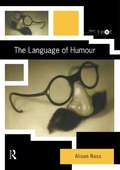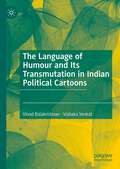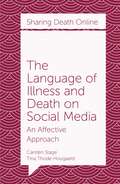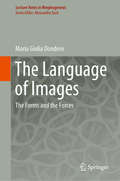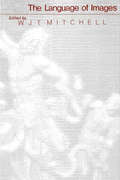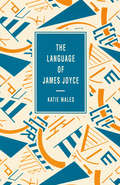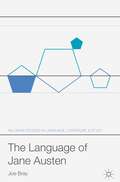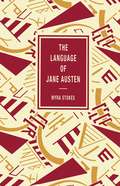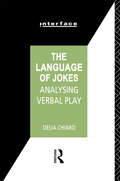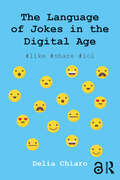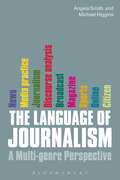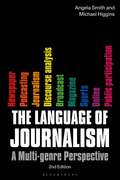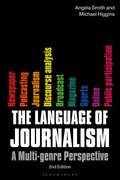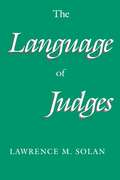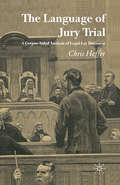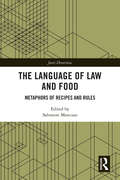- Table View
- List View
The Language of Humour
by Alison RossThe Language of Humour:* examines the importance of the social context for humour* explores the issue of gender and humour in areas such as the New Lad culture in comedy and stand-up comedy* includes comic transcripts from TV sketches such as Clive Anderson and Peter Cook
The Language of Humour and Its Transmutation in Indian Political Cartoons
by Vinod Balakrishnan Vishaka VenkatThis book develops a model to examine the language of humour, which is multimodal and accounts for the possibility of transmutation of humour as it is performed through editorial cartoons. By transmutation is meant the transition in the language of humour when it crosses its own boundaries to provoke unprecedented reactions resulting in offensiveness, disappointment or hurt sentiment. The transmutability about the language of humour points to its inherently diabolical nature which manifests in the performance of controversial cartoons. The model is built by borrowing theoretical cues from Roman Jakobson, Roland Barthes, George Lakoff and Mark Johnson. The integrated model, then, is developed to examine the cartoons which were recommended for deletion by the Thorat Committee, following a cartoon controversy in India. Through the cartoon analysis, the model discerns the significance of context and temporality in determining the impact of humour. It also examines how the ethics of humour; the blurred lines of political correctness and incorrectness are dictated by the political atmosphere and the power dynamics.
The Language of Illness and Death on Social Media: An Affective Approach (Sharing Death Online)
by Carsten Stage Tina Thode HougaardThis book investigates the language created and used on social media to express and respond to personal experiences of illness, dying and mourning. The authors begin by setting out the established and recent research on social and existential media, affect and language, before focusing on Facebook groups dealing with the illness and death of two Danish children. Through these in-depth case studies, they produce insights into different ways of engaging in affective processes related to illness and death on social media, and into both the ritualized and innovative vernacular vocabulary created through these encounters. Developing an analytical framework for understanding the social role and logics of "affective language" (such as emojis, interjections and other forms of expressive interactive writing), The Language of Illness and Death on Social Media will be of great interest to all those striving to understand the affective importance and roles of language for sharing experiences of illness, death and commemoration in these spheres.
The Language of Images: The Forms and the Forces (Lecture Notes in Morphogenesis)
by Maria Giulia DonderoThis book deals with two fundamental issues in the semiotics of the image. The first is the relationship between image and observer: how does one look at an image? To answer this question, this book sets out to transpose the theory of enunciation formulated in linguistics over to the visual field. It also aims to clarify the gains made in contemporary visual semiotics relative to the semiology of Roland Barthes and Emile Benveniste. The second issue addressed is the relation between the forces, forms and materiality of the images. How do different physical mediums (pictorial, photographic and digital) influence visual forms? How does materiality affect the generativity of forms? On the forces within the images, the book addresses the philosophical thought of Gilles Deleuze and René Thom as well as the experiment of Aby Warburg’s Atlas Mnemosyne. The theories discussed in the book are tested on a variety of corpora for analysis, including both paintings and photographs, taken from traditional as well as contemporary sources in a variety of social sectors (arts and sciences). Finally, semiotic methodology is contrasted with the computational analysis of large collections of images (Big Data), such as the “Media Visualization” analyses proposed by Lev Manovich and Cultural Analytics in the field of Computer Science to evaluate the impact of automatic analysis of visual forms on Digital Art History and more generally on the image sciences.
The Language of Images (A Critical Inquiry Book)
by W. J. Mitchell"A remarkably rich and provocative set of essays on the virtually infinite kinds of meanings generated by images in both the verbal and visual arts. Ranging from Michelangelo to Velazquez and Delacroix, from the art of the emblem book to the history of photography and film, The Language of Images offers at once new ways of thinking about the inexhaustibly complex relation between verbal and iconic representation."—James A. W. Heffernan, Dartmouth College
The Language Of Inclusive Education: Exploring Speaking, Listening, Reading And Writing (PDF)
by Elizabeth WaltonThe Language of Inclusive Education is an insightful text which considers the writing, speaking, reading and hearing of inclusive education. Based on the premise that humans use language to construct their worlds and their realities, this book is concerned with how language works to determine what we know and understand about issues related to in/exclusion in education. Using a variety of analytical tools, the author exposes language-at-work in academic and popular literature and in policy documents. Areas of focus include: What inclusive education means and how it is defined How metaphor works to position inclusive education How textbooks construct inclusive education#65533; How we use language to build what we understand to be difference and disability, with particular reference to AD(H)D and Asperger#65533;s Syndrome Listening to children and young people as a means to promote inclusion in schools Woven through this volume is the argument for a more critical awareness of how we use language in the field that we call #65533;inclusive education#65533;. This book is a must-read for any individual studying, practicing or an interest in inclusion and#65533; exploring the associations with language.
The Language Of Inclusive Education: Exploring Speaking, Listening, Reading And Writing
by Elizabeth WaltonThe Language of Inclusive Education is an insightful text which considers the writing, speaking, reading and hearing of inclusive education. Based on the premise that humans use language to construct their worlds and their realities, this book is concerned with how language works to determine what we know and understand about issues related to in/exclusion in education. Using a variety of analytical tools, the author exposes language-at-work in academic and popular literature and in policy documents. Areas of focus include: What inclusive education means and how it is defined How metaphor works to position inclusive education How textbooks construct inclusive education#65533; How we use language to build what we understand to be difference and disability, with particular reference to AD(H)D and Asperger#65533;s Syndrome Listening to children and young people as a means to promote inclusion in schools Woven through this volume is the argument for a more critical awareness of how we use language in the field that we call #65533;inclusive education#65533;. This book is a must-read for any individual studying, practicing or an interest in inclusion and#65533; exploring the associations with language.
The Language of Interstate Relations: In Search of Personification
by P. TwardziszIn challenging the widely held belief in the ubiquity of the personification of the political state, this book strives to de-politicize research and to de-mystify conceptual metaphor. Opposed to mainstream cognitive assumptions, it provides detailed data-driven research and one realistic solution to many of the dilemmas.
The Language of Irish Literature (The Language of Literature)
The Language of Irish Literature is the first book on the market to discuss Irish Literature in terms of the history of, and the linguistic contacts in, the island. It provides a description of the development of the varieties of English in Ireland, concentrating on the input from Irish Gaelic and Scots as well as English. It examines the history of English in Ireland; the nature of Irish and of Irish Englishes; oral traditions: songs and stories; and the three main literary genres: drama, poetry and prose.
The Language of James Joyce (The Language of Literature)
by Katie Wales Geoff ScottThis book presents the first sustained analysis for students of the language and style of Joyce's major prose works in the light of current work in language studies, stylistics and literary theory. Each chapter addresses a particular aspect of the style of a prose work or text, rhetoric (Dubliners, and A Portrait of the Artist as a Young Man), speech and thought presentation and word-play (Ulysses) and sound-play (Finnegans Wake). The book is written specifically for undergraduates and general readers interested in Joyce who may lack a linguistic background.
The Language of Jane Austen (Language, Style and Literature)
by Joe BrayJoe Bray’s careful analysis of Jane Austen’s stylistic techniques reveals that the genius of her writing is far from effortless; rather he makes the case for her as a meticulous craftswoman and a radical stylistic pioneer. Countering those who have detected in her novels a dominant, authoritative perspective, Bray begins by highlighting the complex, ever-shifting and ambiguous nature of the point of view through which her narratives are presented. This argument is then advanced through an exploration of the subtle representation of speech, thought and writing in Austen’s novels. Subsequent chapters investigate and challenge the common critical associations of Austen’s style with moral prescriptivism, ideas of balance and harmony, and literal as opposed to figurative expression. The book demonstrates that the wit and humour of her fiction is derived instead from a complex and subtle interplay between different styles. This compelling reassessment of Austen’s language will offer a valuable resource for students and scholars of stylistics, English literature and language and linguistics.
The Language of Jane Austen: A Study Of Some Aspects Of Her Vocabulary
by Myra Stokes N F BlakeThis study examines in detail the vocabulary associated with each of the four main components of 'character' in Jane Austen's work: head, heart, spirits, manners. By comparing Jane Austen's use of these words with their use in other literature of the period, Myra Stokes enhances our understanding not only of Jane Austen's prose, but also of the nineteenth-century society in which she lived.
The Language of Jokes: Analyzing Verbal Play (Interface)
by Delia ChiaroIn this highly readable and thought-provoking book, Delia Chiaro explores the pragmatics of word play, using frameworks normally adopted in descriptive linguistics. Using examples from personally recorded conversations, she examines the structure of jokes, quips, riddles and asides. Chiaro explores degrees of conformity to and deviation from established conventions; the `tellability' of jokes, and the interpretative role of the listener; the creative use of puns, word play and discourse. The emphasis in her analysis is on sociocultural contexts for the production and reception of jokes, and she examines the extent to which jokes are both universal in their appeal, and specific to a particular culture.
The Language of Jokes: Analyzing Verbal Play (Interface)
by Delia ChiaroIn this highly readable and thought-provoking book, Delia Chiaro explores the pragmatics of word play, using frameworks normally adopted in descriptive linguistics. Using examples from personally recorded conversations, she examines the structure of jokes, quips, riddles and asides. Chiaro explores degrees of conformity to and deviation from established conventions; the `tellability' of jokes, and the interpretative role of the listener; the creative use of puns, word play and discourse. The emphasis in her analysis is on sociocultural contexts for the production and reception of jokes, and she examines the extent to which jokes are both universal in their appeal, and specific to a particular culture.
The Language of Jokes in the Digital Age: Viral Humour
by Delia ChiaroIn this accessible book, Delia Chiaro provides a fresh overview of the language of jokes in a globalized and digitalized world. The book shows how, while on the one hand the lingua-cultural nuts and bolts of jokes have remained unchanged over time, on the other, the time-space compression brought about by modern technology has generated new settings and new ways of joking and playing with language. The Language of Jokes in the Digital Age covers a wide range of settings from social networks, e-mails and memes, to more traditional fields of film and TV (especially sitcoms and game shows) and advertising. Chiaro’s consideration of the increasingly virtual context of jokes delights with both up-to-date examples and frequent reference to the most central theories of comedy. This lively book will be essential reading for any student or researcher working in the area of language and humour and will be of interest to those in language and media and sociolinguistics.
The Language of Jokes in the Digital Age: Viral Humour
by Delia ChiaroIn this accessible book, Delia Chiaro provides a fresh overview of the language of jokes in a globalized and digitalized world. The book shows how, while on the one hand the lingua-cultural nuts and bolts of jokes have remained unchanged over time, on the other, the time-space compression brought about by modern technology has generated new settings and new ways of joking and playing with language. The Language of Jokes in the Digital Age covers a wide range of settings from social networks, e-mails and memes, to more traditional fields of film and TV (especially sitcoms and game shows) and advertising. Chiaro’s consideration of the increasingly virtual context of jokes delights with both up-to-date examples and frequent reference to the most central theories of comedy. This lively book will be essential reading for any student or researcher working in the area of language and humour and will be of interest to those in language and media and sociolinguistics.
The Language of Journalism: Volume 1, Newspaper Culture (Language Of Journalism Ser.)
by Melvin J. LaskyThe newspaper is to the twentieth century what the novel was for the nineteenth century: the expression of popular sentiment. In the first of a three-volume study of journalism and what it has meant as a source of knowledge and as a mechanism for orchestrating mass ideology, Melvin J. Lasky provides a major overview. His research runs the gamut of material found in newspapers, from the trivial to the profound, from pseudo-science to habits of solid investigation.The volume is divided into four parts. The first attacks deficiencies in grammar and syntax with examples from newspapers and magazines drawn from the German as well as English-language press. The second examines the key issues of journalism: accuracy and authenticity. Lasky provides an especially acute account of differences between active literacy and passive viewing, or the relationship of word and picture in defining authenticity.The third part emphasizes the problem of bias in everything from racial reporting to cultural correctness. This is the first systematic attempt to study racial nomenclature, identity-labeling, and literary discrimination. Lasky follows closely the model set by George Orwell a half century earlier. The final section of the work covers the competition between popular media and the redefinition of pornography and its language. The volume closes with an examination of how the popular culture both influenced and was influential upon literary titans like Hemingway, Lawrence, and Tynan.
The Language of Journalism: Volume 1, Newspaper Culture
by Melvin J. LaskyThe newspaper is to the twentieth century what the novel was for the nineteenth century: the expression of popular sentiment. In the first of a three-volume study of journalism and what it has meant as a source of knowledge and as a mechanism for orchestrating mass ideology, Melvin J. Lasky provides a major overview. His research runs the gamut of material found in newspapers, from the trivial to the profound, from pseudo-science to habits of solid investigation.The volume is divided into four parts. The first attacks deficiencies in grammar and syntax with examples from newspapers and magazines drawn from the German as well as English-language press. The second examines the key issues of journalism: accuracy and authenticity. Lasky provides an especially acute account of differences between active literacy and passive viewing, or the relationship of word and picture in defining authenticity.The third part emphasizes the problem of bias in everything from racial reporting to cultural correctness. This is the first systematic attempt to study racial nomenclature, identity-labeling, and literary discrimination. Lasky follows closely the model set by George Orwell a half century earlier. The final section of the work covers the competition between popular media and the redefinition of pornography and its language. The volume closes with an examination of how the popular culture both influenced and was influential upon literary titans like Hemingway, Lawrence, and Tynan.
The Language of Journalism: A Multi-genre Perspective
by Angela Smith Michael HigginsThe Language of Journalism aims to provide an accessible, wide-ranging introductory textbook for a range of students. The book explores the significance of a range of linguistic practices occurring in journalism, demonstrating and facilitating the use of analysis in aiding professional journalistic and media practice.The book introduces the differences in language conventions that develop across media platforms. It covers all the key journalistic mediums available today, including sport, online and citizen journalism alongside the more standard chapters on magazine, newspaper and broadcast journalism. Clearly written and structured, this will be a key text for journalism students.
The Language of Journalism: A Multi-genre Perspective
by Angela Smith Michael HigginsThe Language of Journalism aims to provide an accessible, wide-ranging introductory textbook for a range of students. The book explores the significance of a range of linguistic practices occurring in journalism, demonstrating and facilitating the use of analysis in aiding professional journalistic and media practice.The book introduces the differences in language conventions that develop across media platforms. It covers all the key journalistic mediums available today, including sport, online and citizen journalism alongside the more standard chapters on magazine, newspaper and broadcast journalism. Clearly written and structured, this will be a key text for journalism students.
The Language of Journalism: A Multi-Genre Perspective
by Angela Smith Michael HigginsThe Language of Journalism (2nd edition) provides lively and accessible tools to understand and analyse the language of journalism. The authors explain how language develops across divergent media platforms, old and new, by looking at the differences across various forms of journalism – including broadcast, magazine, newspaper, sports, radio, and online and citizen. As well as introducing the reader to the principles and methods of discourse analysis and how it can be applied to media, the book addresses the dynamic interplay between the emerging linguistic forms of social media and the journalistic field.With this new edition, the authors draw upon a range of international examples, including from the USA, India, Australia, China and the UK. They focus on an exploration of how social media is incorporated into the journalistic output of print media, with a particular focus on 'clickbait'. This edition also focuses on the global ambitions of online newspapers – such as the Daily Mail and the Guardian – which are UK based, but have Australian and US subsections.
The Language of Journalism: A Multi-Genre Perspective
by Angela Smith Michael HigginsThe Language of Journalism (2nd edition) provides lively and accessible tools to understand and analyse the language of journalism. The authors explain how language develops across divergent media platforms, old and new, by looking at the differences across various forms of journalism – including broadcast, magazine, newspaper, sports, radio, and online and citizen. As well as introducing the reader to the principles and methods of discourse analysis and how it can be applied to media, the book addresses the dynamic interplay between the emerging linguistic forms of social media and the journalistic field.With this new edition, the authors draw upon a range of international examples, including from the USA, India, Australia, China and the UK. They focus on an exploration of how social media is incorporated into the journalistic output of print media, with a particular focus on 'clickbait'. This edition also focuses on the global ambitions of online newspapers – such as the Daily Mail and the Guardian – which are UK based, but have Australian and US subsections.
The Language of Judges (Chicago Series in Law and Society)
by Lawrence M. SolanSince many legal disputes are battles over the meaning of a statute, contract, testimony, or the Constitution, judges must interpret language in order to decide why one proposed meaning overrides another. And in making their decisions about meaning appear authoritative and fair, judges often write about the nature of linguistic interpretation. In the first book to examine the linguistic analysis of law, Lawrence M. Solan shows that judges sometimes inaccurately portray the way we use language, creating inconsistencies in their decisions and threatening the fairness of the judicial system. Solan uses a wealth of examples to illustrate the way linguistics enters the process of judicial decision making: a death penalty case that the Supreme Court decided by analyzing the use of adjectives in a jury instruction; criminal cases whose outcomes depend on the Supreme Court's analysis of the relationship between adverbs and prepositional phrases; and cases focused on the meaning of certain words in the Constitution. Solan finds that judges often describe our use of language poorly because there is no clear relationship between the principles of linguistics and the jurisprudential goals that the judge wishes to promote. A major contribution to the growing interdisciplinary scholarship on law and its social and cultural context, Solan's lucid, engaging book is equally accessible to linguists, lawyers, philosophers, anthropologists, literary theorists, and political scientists.
The Language of Jury Trial: A Corpus-Aided Analysis of Legal-Lay Discourse
by C. HefferDrawing on representative corpora of transcripts from over 100 English criminal jury trials, this stimulating new book explores the nature of 'legal-lay discourse', or the language used by legal professionals before lay juries. Careful analyses of genres such as witness examination and the judge's summing-up reveal a strategic tension between a desire to persuade the jury and the need to conform to legal constraints. The book also suggests ways of managing this tension linguistically to help, not hinder, the jury.
The Language of Law and Food: Metaphors of Recipes and Rules (Juris Diversitas)
by Salvatore MancusoThis book reconsiders the use of food metaphors and the relationship between law and food in an interdisciplinary perspective to examine how food related topics can be used to describe or identify rules, norms, or prescriptions of all kinds. The links between law and food are as old as the concept of law. Many authors have been using such links in creative ways to express specific features of law. This is because the language of food and cooking offers legal thinkers and teachers mouth-watering metaphors, comparing rules to recipes, and their combination to culinary processes. This collection focuses on this relationship between law and food and takes us far beyond their mere interaction, to explore different ways of using these two apparently so diverse elements to describe different phenomena of the legal reality. The authors use the link between food and law to describe different aspects of the legal landscape in different areas and jurisdictions. Bringing together metaphors and indirect correlations between law and food, the book explores different models of approaching legal issues and considering different legal challenges from a completely new perspective, in line with the multidisciplinary approach that leads comparative legal studies today and, to a certain extent, revisiting and enriching it. With contributions in English and French, the book will be of interest to academics and researchers working in the areas of law and food, law and language, and comparative legal studies.
